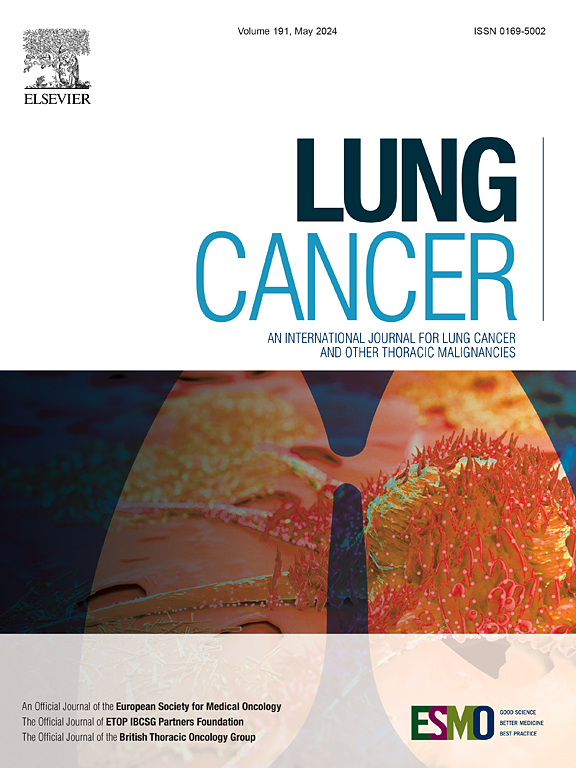与洛拉替尼相关的体重增加和血脂异常:回顾性分析及对未来治疗的影响。
IF 4.5
2区 医学
Q1 ONCOLOGY
引用次数: 0
摘要
研究目的我们研究的目的是在现实世界中确定与洛拉替尼相关的体重增加和血脂异常的发生率和严重程度,以指导未来减轻这些毒性的治疗策略:我们对英国一家机构在2016年11月至2022年11月期间开始使用lorlatinib的ALK和ROS1阳性NSCLC患者进行了回顾性观察分析。非小细胞肺癌(NSCLC)患者的处方是通过机构电子药房记录确定的。进行了描述性分析。未记录基线体重的患者排除在分析之外。体重、体重指数(BMI)、甘油三酯和总/低密度脂蛋白(LDL)/高密度脂蛋白(HDL)胆固醇的变化由连续测量值计算得出,并根据 CTCAE v5.0 进行分级:对 43 名患者进行了评估。81%的患者服用洛拉替尼后体重增加(中位数:4.5千克,比基线增加6.5%);分级结论:体重增加和血脂异常是使用lorlatinib时经常出现的症状,因此需要采取有效的药物和非药物策略来控制这些毒性反应。其发生率与CROWN试验报告的结果相似。鉴于CROWN试验中显示的5年无进展生存期(PFS)为60%,减轻治疗相关毒性至关重要,这样才能最大限度地降低对患者生活质量(QOL)的影响,并减少这一NSCLC亚组患者与癌症无关的发病率,从而获得理想的治疗效果。本文章由计算机程序翻译,如有差异,请以英文原文为准。
Lorlatinib-associated weight gain and dyslipidaemia: A retrospective analysis and implications for future care
Objectives
The objective of our study was to benchmark the incidence and severity of lorlatinib-related weight gain and dyslipidaemia in a real-world context, to guide future therapeutic strategies to mitigate these toxicities.
Methods
We conducted a retrospective, observational analysis of patients with ALK and ROS1-positive NSCLC at a single institution in the UK who were commenced on lorlatinib from 11/2016 to 11/2022. Non-small cell lung cancer (NSCLC) patients prescribed lorlatinib were identified through institutional electronic pharmacy records. Descriptive analyses were conducted. Patients without recorded baseline weight were excluded from the analysis. Changes in weight, body mass index (BMI), triglycerides, and total/low-density lipoprotein (LDL)/high-density lipoprotein (HDL) cholesterol were calculated from serial measurements and graded in accordance with CTCAE v5.0.
Results
43 patients were evaluated. 81 % of patients developed weight gain on lorlatinib (median: 4.5 kg, 6.5 % increase from baseline); Grade < 1 in 37 % (n = 16/43), Grade 1 in 23 % (n = 10/43), Grade 2 in 12 % (n = 5/43), and Grade ≥ 3 in 9 % (n = 4/43). BMI increase was observed in 79 % of patients. 35 % of patients with healthy baseline BMI moved into overweight/obese categories.
Of patients with recorded baseline lipid levels, 91 % developed increase in total cholesterol, and 68 % an increase in triglycerides, respectively. 7 % (n = 1/15) patients with normal baseline total cholesterol developed Grade ≥ 3 elevated cholesterol; no patients with normal baseline triglycerides developed Grade ≥ 3 elevated hypertriglyceridaemia (n = 12). Median time to onset of total cholesterol elevation was 21 days. Lipid-lowering therapy was required in most patients (86 %). One patient developed a non-ST elevation myocardial infarction (NSTEMI) which may have been attributable to lorlatinib.
Conclusion
Weight gain and dyslipidaemia are commonly observed with lorlatinib, highlighting the need for effective pharmacologic and non-pharmacologic strategies to manage these toxicities. Rates were similar to those reported in the CROWN trial. Given the 60 % 5-year progression-free survival (PFS) demonstrated in CROWN, mitigation of treatment-related toxicities is paramount to minimise impact on patient quality of life (QOL) and cancer-independent morbidity in this subgroup of NSCLC patients with favourable outcomes.
求助全文
通过发布文献求助,成功后即可免费获取论文全文。
去求助
来源期刊

Lung Cancer
医学-呼吸系统
CiteScore
9.40
自引率
3.80%
发文量
407
审稿时长
25 days
期刊介绍:
Lung Cancer is an international publication covering the clinical, translational and basic science of malignancies of the lung and chest region.Original research articles, early reports, review articles, editorials and correspondence covering the prevention, epidemiology and etiology, basic biology, pathology, clinical assessment, surgery, chemotherapy, radiotherapy, combined treatment modalities, other treatment modalities and outcomes of lung cancer are welcome.
 求助内容:
求助内容: 应助结果提醒方式:
应助结果提醒方式:


